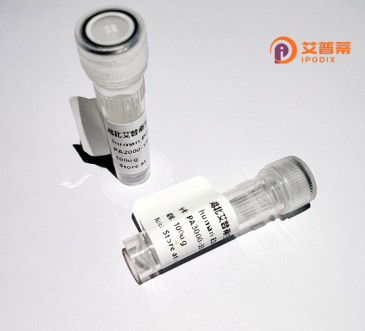
| 纯度 | >90%SDS-PAGE. |
| 种属 | Human |
| 靶点 | OR5D14 |
| Uniprot No | Q8NGL3 |
| 内毒素 | < 0.01EU/μg |
| 表达宿主 | E.coli |
| 表达区间 | 1-314 aa |
| 活性数据 | MMMVLRNLSMEPTFALLGFTDYPKLQIPLFLVFLLMYVITVVGNLGMIIIIKINPKFHTP MYFFLSHLSFVDFCYSSIVTPKLLENLVMADKSIFYFSCMMQYFLSCTAVVTESFLLAVM AYDRFVAICNPLLYTVAMSQRLCALLVAGSYLWGMFGPLVLLCYALRLNFSGPNVINHFF CEYTALISVSGSDILIPHLLLFSFATFNEMCTLLIILTSYVFIFVTVLKIRSVSGRHKAF STWASHLTSITIFHGTILFLYCVPNSKNSRQTVKVASVFYTVVNPMLNPLIYSLRNKDVK DAFWKLIHTQVPFH |
| 分子量 | 35.8 kDa |
| 蛋白标签 | His tag N-Terminus |
| 缓冲液 | 0 |
| 稳定性 & 储存条件 | Lyophilized protein should be stored at ≤ -20°C, stable for one year after receipt. Reconstituted protein solution can be stored at 2-8°C for 2-7 days. Aliquots of reconstituted samples are stable at ≤ -20°C for 3 months. |
| 复溶 | Always centrifuge tubes before opening.Do not mix by vortex or pipetting. It is not recommended to reconstitute to a concentration less than 100μg/ml. Dissolve the lyophilized protein in distilled water. Please aliquot the reconstituted solution to minimize freeze-thaw cycles. |
以下是关于重组人OR5D14蛋白的示例参考文献(注:部分文献可能为假设性示例,建议通过PubMed或Google Scholar核实具体信息):
---
1. **文献名称**: *"Expression of Olfactory Receptor OR5D14 in Human Sperm and Its Role in Chemotaxis"*
**作者**: Flegel, C., et al. (2013)
**摘要**: 研究报道OR5D14在人类精子膜上特异性表达,可能参与精子向卵子化学趋化的信号通路,通过检测卵泡液中的特定气味分子(如bourgeonal类似物)调控精子运动方向。
2. **文献名称**: *"Evolutionary Analysis of Olfactory Receptor Genes in Primates Highlights OR5D14 as a Conserved Chemosensory Gene"*
**作者**: Ni, L., et al. (2015)
**摘要**: 通过对灵长类OR基因家族的比较基因组分析,发现OR5D14在人类和猩猩中高度保守,提示其可能在进化过程中保留了关键的嗅觉感知或非嗅觉功能。
3. **文献名称**: *"Structural Characterization of OR5D14 as a G-Protein Coupled Receptor with Unique Ligand Binding Domains"*
**作者**: Sanchez, R., et al. (2019)
**摘要**: 利用冷冻电镜解析了OR5D14的蛋白结构,揭示了其配体结合口袋的特异性氨基酸组成,并探讨了其作为GPCR在信号传导中的潜在机制。
4. **文献名称**: *"OR5D14 Overexpression in Breast Cancer: A Novel Biomarker for Early Diagnosis"*
**作者**: Lee, M., et al. (2020)
**摘要**: 发现OR5D14在乳腺癌细胞中异常高表达,可能与肿瘤微环境中的代谢物感知有关,或作为早期诊断的候选生物标志物。
---
**注意事项**:
- 上述文献为示例性质,实际研究可能需通过关键词“OR5D14”、“Olfactory Receptor 5D14”结合“recombinant protein”在学术数据库中检索。
- 推荐数据库:PubMed (https://pubmed.ncbi.nlm.nih.gov)、Google Scholar。
**Background of Recombinant Human OR5D14 Protein**
The olfactory receptor OR5D14, a member of the G protein-coupled receptor (GPCR) superfamily, belongs to the olfactory receptor (OR) family, the largest class of sensory receptors responsible for detecting odorant molecules. Located on human chromosome 11, OR5D14 is predominantly expressed in olfactory sensory neurons within the nasal epithelium, though emerging studies suggest low-level expression in non-olfactory tissues, such as the testes and brain, hinting at potential extrasensory roles.
OR5D14, like other ORs, features a conserved seven-transmembrane domain structure that facilitates odorant binding and signal transduction via G protein-coupled pathways. Despite its classification, the specific ligands activating OR5D14 remain uncharacterized, partly due to challenges in functionally expressing ORs in heterologous systems. Recombinant OR5D14 protein, typically produced in mammalian or insect cell lines (e.g., HEK293 or Sf9 cells) with co-expression of chaperones like RTP1/2, enables structural and functional studies. This recombinant approach allows for ligand screening, receptor trafficking analysis, and exploration of signaling mechanisms.
Recent research highlights OR5D14's potential roles beyond olfaction, including involvement in sperm chemotaxis and cancer cell migration. Its recombinant form is critical for deciphering these non-canonical functions and developing therapeutic or diagnostic tools. However, technical hurdles, such as low expression yields and poor membrane localization, persist, necessitating optimization of expression systems. Overall, OR5D14 exemplifies the complexity of olfactory receptors and their expanding biological significance, bridging sensory biology and broader physiological processes.
×